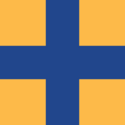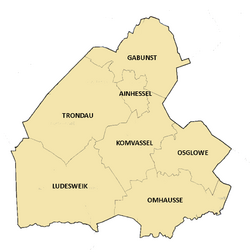Ainhessel
Principality of Ainhessel Voordstedom Ainheijssel (Ainhessen) | |
|---|---|
Motto: Vreiheit Freedom | |
| Capital | Ainhessel |
| Largest | Ainhessel |
| Official languages | Ainhessen |
| Demonym(s) | Ainhessen |
| Government | Unitary parliamentary constitutional monarchy with directional government |
• Princess | Larna of Ainhessel |
• Government | Council of The State (Ainhessel) |
| Legislature | Parliament of Ainhessel |
| Establishment | |
• Foundation of The County of Ainhessel | 968 |
• Expansion | 1234 |
• War of Agression | 1328 |
| Area | |
• | 2,488 km2 (961 sq mi) |
| Population | |
• 2019 estimate | 490,788 |
• 2017 census | 485,500 |
| GDP (PPP) | 200 estimate |
• Total | $5.3 billion (68 billion UTP) |
• Per capita | 75,899 UTP |
| GDP (nominal) | 2019 estimate |
• Total | 71 billion UTP |
• Per capita | 78,000 UTP |
| HDI (2019) | very high |
| Currency | Ainhessen Marche (AHM) |
| Driving side | right |
| Calling code | +488 |
| Internet TLD | .ah |
Ainhessel, officially the Principality of Ainhessel (Ainhessen: Voordstedom Ainheijssel) is a Utopian sovereign microstate located in North Utopia. It is completley surrounded by New Daarlerveen. In total, Ainhessel covers 2,488 km2. It is inhabited by 490,000 people making it one of the smallest and most densely populated nations in the world. Its capital and largest city is Ainhessel.
History
Early History
Birth of the house of Ainhessel
Wars of Weren Aggression (1514-1523)
Enlightenment and age of progress (18th and 19th centuries)
Schism of the crown (1859)
Early 20th century
Economic downturn (1972-1983)
Modern history
Geography
The country is for the most part flat, with the exception of foothills in the south in the kommunes of Osglowe and Omhausse, up to a height of 670 metres, and some low hill ranges in the central parts. Since the late 16th century, large polder areas are preserved through elaborate drainage systems that include many canals. The main two rivers are the Aise and the Merne. The country's highest point is Vaumpoller at 670 metres.
Climate
Ainhessel has a mild continental climate, with moderately warm summers and cool winters, and typically high humidity. Ice days—maximum temperature below 0 °C (32 °F)—usually occur from December until February, with the occasional rare ice day prior to or after that period. Freezing days—minimum temperature below 0 °C (32 °F)—occur much more often, usually ranging from mid-November to late March, but not rarely measured as early as mid-October and as late as mid-May. If one chooses the height of measurement to be 10 cm (4 in) above ground instead of 150 cm (59 in), one may even find such temperatures in the middle of the summer. On average, snow can occur from November to April but sometimes occurs in May or October too.
Warm days—maximum temperature above 20 °C (68 °F)—are usually found in April to October, but in some parts of the country these warm days can also occur in March, or even sometimes in November or February. Summer days—maximum temperature above 25 °C (77 °F)—are usually measured in De Bilt from May until September, tropical days—maximum temperature above 30 °C (86 °F)—are rare and usually occur only in June to August.
Nature
Ainhessel has 12 national parks and other nature reserves, that include lakes, heathland, woods and other habitats. Most of these are owned by the national department for forestry and The Voslandstaacht, a private organisation that buys, protects and manages nature reserves.
Government and Politics
Government
Ainhessel is a constitutional monarchy with the Prince of Ainhessel as its head of state.
The Constitution adopted in 1714 and rewritten in 1983 is the legal foundation of the modern federal state. It outlines basic and political rights of individuals and citizen participation in public affairs, divides the powers between the Monarchy and the Kommunes and defines jurisdiction and authority. There are three main governing bodies of the Ainhessen government: the unicameral parliament (legislative), the Council of the State (executive) and The High court of Ainhessel (judicial).
The Ainhessen Parliament consists of one house of 60 representative who are elected under a system determined by the Council of The State elected under a system of proportional representation, depending on the population of each kommune. Members of the house serve for 4 years and only serve as members of parliament part-time. Through referendums, citizens may challenge any law passed by parliament and through initiatives, introduce amendments to the federal constitution, thus making Ainhessel a direct democracy.
Council of The State constitutes the government, directs the administration and serves as collective Head of Government. It is a collegial body of seven members, elected for a four-year mandate by the people of Ainhessel. The Parliament of Ainhessel also exercises oversight over the council.
The Ainhessen government has been a coalition of the three major political parties since 1957, each party having a number of seats that roughly reflects its share of electorate and representation in the parliament.
Administrative Divisions
Ainhessel is split into seven Kommunes.
| Name in English | Name in Ainhessen | Administrative seat | Population (2020) |
|---|---|---|---|
| Gabunst | Gaabaunst | 22,000 | |
| Ainhessel (Kommune) | Ainheijssel | 320,000 | |
| Trondau | Troundau | 43,000 | |
| Komvassel | Kommveijssel | 31,000 | |
| Ludesweik | Ludessweig | 39,000 | |
| Omhausse | Ohmhausse | 22,422 | |
| Osglowe | Ossglov | 14,366 |
Economy
Ainhessel's stable and high-income market economy features moderate growth, low inflation, and a high level of innovation. Unemployment is traditionally low, with a per capita GDP on a purchasing-power parity (PPP) basis of 75,119 UTP. Its GDP per capita in purchasing power standards was 261% of the UU average (100%) in 2019.
The industrial sector, which was dominated by steel until the 1950s, has since diversified to include chemicals, rubber, and other products. During the past decades, growth in the financial sector has more than compensated for the decline in steel production. Services, especially banking and finance, account for the majority of the economic output. Ainhessel is the world's third largest investment fund center, the most important private banking center in North Utopia and The Utopia's leading center for reinsurance companies.
Currency
The Marche is the official currency of Ainhessen. The currency is sometimes referred to as the Ainhessen Mark in English. Historically, Marche coins have been minted Ainhessel since the 16th century.
Ainhessel has not introduced the Utopia, following a rejection by referendum in 2009, but the Ainhessen Marche is pegged closely to the Utopia. Ainhessel borders one utopiazone member New Daarlerveen.
Demographics
Religion
Religion in Ainhessel has been historically dominated by Christianity between the 10th and 20th centuries. In the late 19th century, roughly 75% of the population was a member of the Church of Ainhessel a protestant church with the rest of the population being Catholic. Since then, there has been a slight decline in both Catholic and Protestant Christianity. There has been a large rise in the secular population as well as that in Ainhessel a small Muslim minority also exists.
Religion in Ainhessel (2020)
Largest Cities
Military and Law Enforcement
The Ainhessen army is mostly based in its casern, the Kenter Caserne in Trondau. The army is under civilian control, with Prince/Princess as Commander-in-Chief. The Minister for Defense, Walter Mahan, oversees army operations. Being a landlocked country, Ainhessel has no navy and only a few aircraft.
Culture
Ainhessel retains a number of folk traditions, having been for much of its history a rural country. There are several notable museums, located mostly in Ainhessel (City). These include the National Museum of History, the Ainhessel City Museum, and the Royal Museum of Ainhessel. The National Museum of Military History in Trondau is especially known for its representations of the War of Agression.
Media
Arts and Literature
Foreign Relations
Ainhessel has long been a prominent supporter of Utopian political and economic integration. Ainhessel has long championed unity in the Utopias and was one of the founding members of the Utopian Union and is a member of the Universal Pact. It also participates in the Free movement area.





